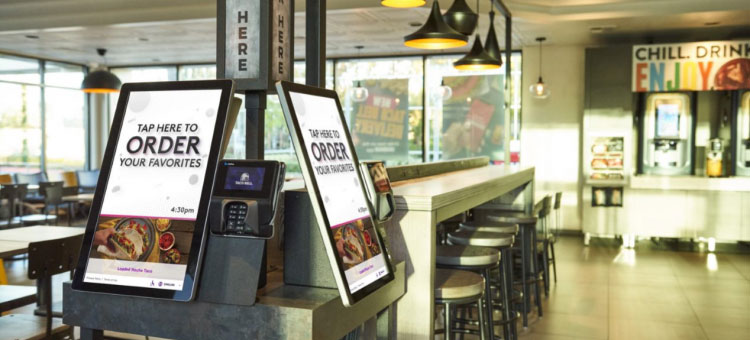February 18, 2020
Mobile Architecture: Self-Service’s Foundation for Customer EngagementMobile Architecture: Self-Service’s Foundation for Customer Engagement

Across hotel lobbies and restaurants to retail shops and corporate offices, interactive devices are increasingly available for people to use. Trips to the local supermarket include self-checkout (SCO) options, while technology in a retail showroom can showcase products that aren't physically in-store. And in the quick-serve restaurant industry, we see heavy hitters like McDonald’s and Taco Bell enhancing guest experiences with next-level interactivity via mobile and touchscreen interfaces.
Businesses are universally embracing self-service solutions, and research shows this trend isn't expected to slow down. According to a recent PYMNTS study, between now and 2021, the American interactive kiosks market is projected to grow by an annual rate of 7.2 percent.
This single-digit number belies the underlying dynamics. The number of installations of interactive systems that provide a richer experience to the customer is growing fast, while applications focused on singular transactions (e.g., ticket printing) is not. To successfully implement and provide flexible self-service solutions to consumers, businesses are adopting mobile architecture. Here’s why.
Customers Are Comfortable With Mobile Experiences
Any business that interacts with consumers in a physical space ought to explore incorporating self-service offerings to improve the customer experience. This starts with determining the ideal architecture of the devices, and how to bring content to them. The architecture you choose should be reliable, secure, easy-to-manage and technologically up-to-date. The experience created through self-service tech must be fresh, aligned with your brand, and consistent with other customer touchpoints.
Using mobile architecture for fixed, in-store devices promises just this — a common experience across web, mobile and on-premise. This means navigating an in-store interface should be as comfortable as browsing the mobile website or app from a smartphone. Enterprises using mobile technology realize additional benefits like faster employee onboarding and training, as well as flexible integration of technology into existing infrastructure. From point-of-sale and self-service to brand experiences and augmented reality demos, Android-powered devices can add flexibility and adaptability to an organization’s self-service offerings.
An Uptick in Mobile Technology Means Available Developer Talent
In recent years, smartphone and tablet shipments have risen in popularity over shipments of desktop and laptop computers. The dominance of mobile technology has in turn shaped many trends, from responsive websites that work across multiple devices to new payment options online and in-store. The demand for mobile apps has contributed to a growing pool of experienced app developers, which means organizations can find diverse talent ready to meet their mobile architecture needs at more affordable prices than in years past.
One Architecture Creates a Cohesive System
The “one architecture” concept isn't new, but it’s gaining renewed importance in the mobile world. Each device — whether phone, tablet, POS system or kiosk — has traditionally been looked at as a standalone entity. However, with the right investments, enterprises can align this technology on the same architecture. This means cost advantages to businesses in compatibility, management and risk assessment, with in-store use cases enabled by a single OS image and management platform.
When businesses can manage all enterprise devices as a coherent digital fabric rather than a mishmash of disparate systems, they can realize a significant reduction in cost and complexity.
While consumers may continually upgrade their mobile devices, businesses need a balanced approach to updates and security in their mobile architecture investments. Making deployments across multiple versions of hardware and operating systems can be challenging. While deploying “old” systems doesn't result in a dynamic customer experience. Already, devices, software and security paradigms are emerging from the world’s leading technology vendors to support the switch to Android. With advantages in speed, cost and reliability, many IT teams will find that pushing themselves to the mobile edge will result in a more efficient solution, one that better aligns with the expectations of their customers.
A Shift to a Consumer and Mobile-First Mind-Set
What's the catalyst behind the growing popularity of self-service? A mobile-first mind-set. Think about your own life as a consumer. Chances are that as soon as you woke up this morning, you interacted with your smartphone to get the latest news updates or remind yourself of the day’s agenda. Mobile has become a permanent companion in our lives, so much so that as consumers we may not be aware that mobile’s influence reaches far beyond the confines of the smartphone.
Mobile technology is present in many consumer touchpoints that may not first appear like mobile technology. From smart factories and interactive dressing rooms to in-app purchasing and fulfillment practices, mobile is a critical factor distinguishing a fun and experiential customer experience from a clunky and outdated shopping experience. And, if utilized properly through a sound mobile architecture strategy, it can serve as the foundation for customer engagement and solution adaptability for years to come.
 Neeraj Pendse
Neeraj Pendse
VP Global Product Management at Elo
Originally published via TotalRetail website.